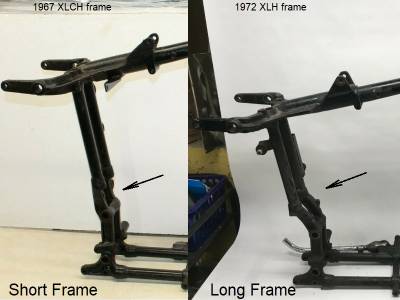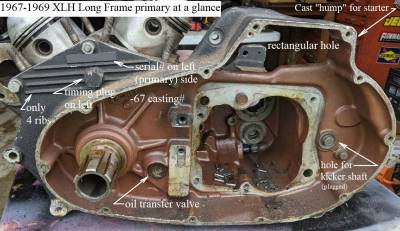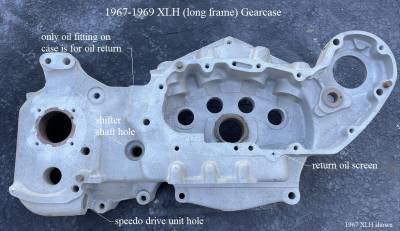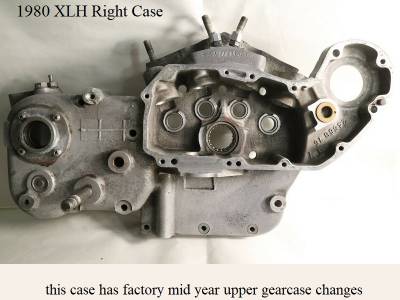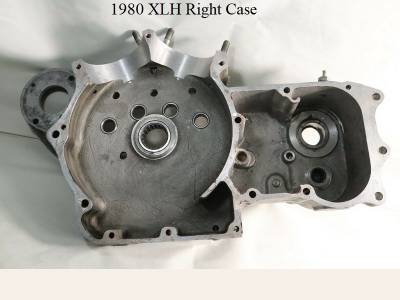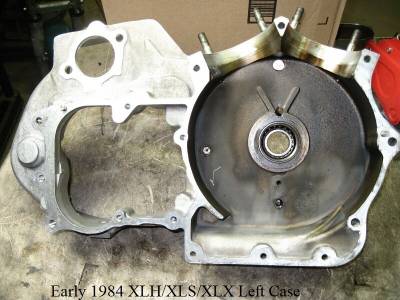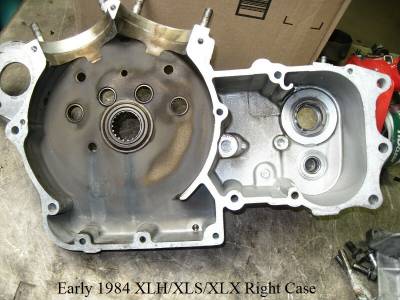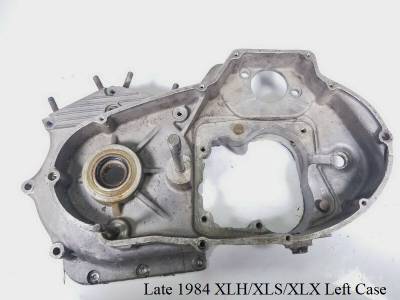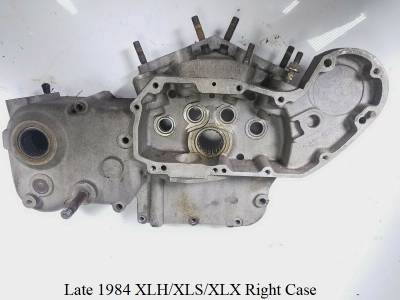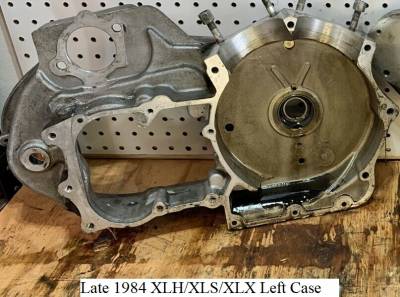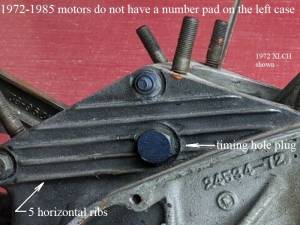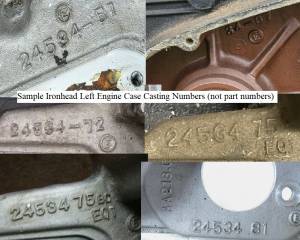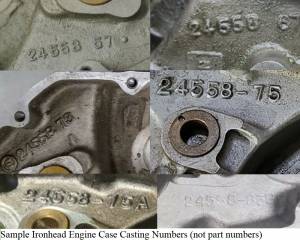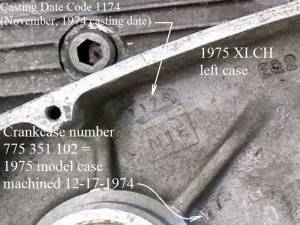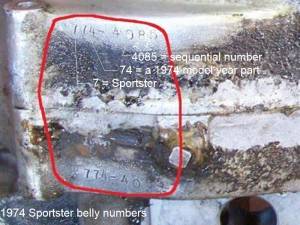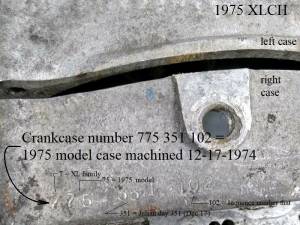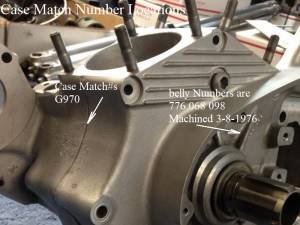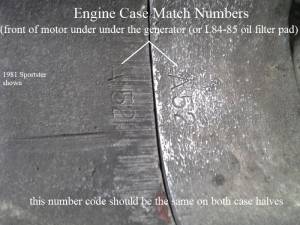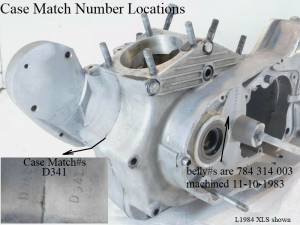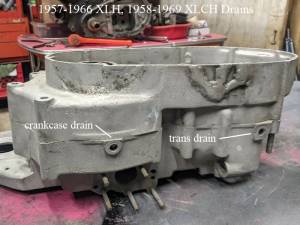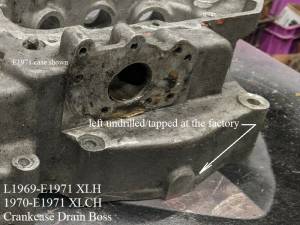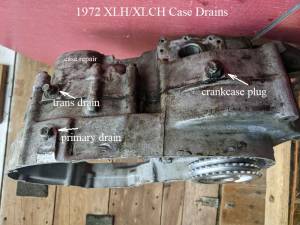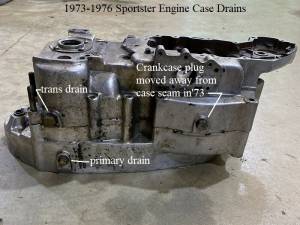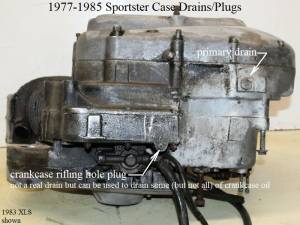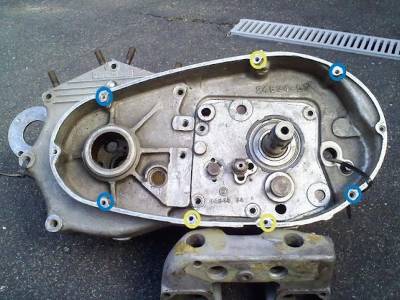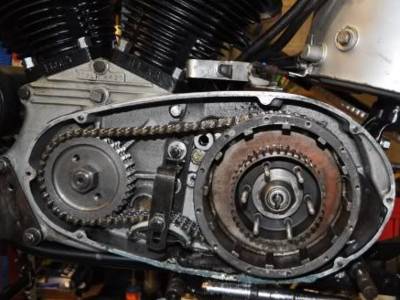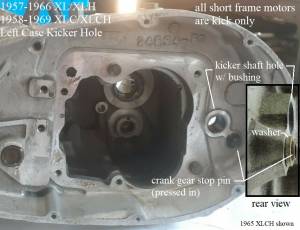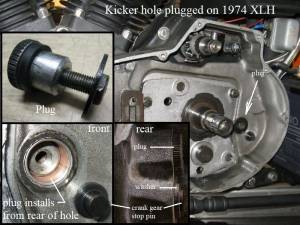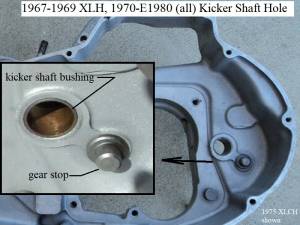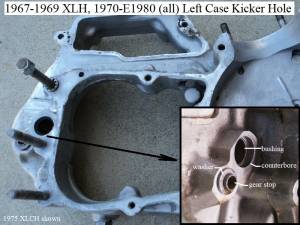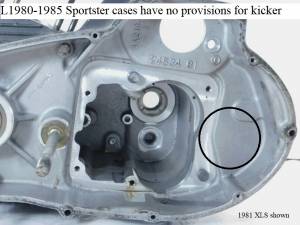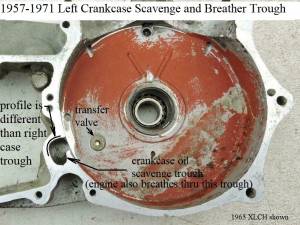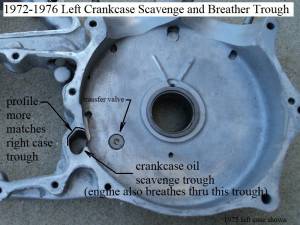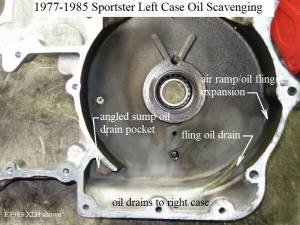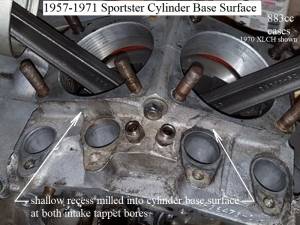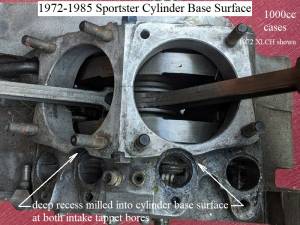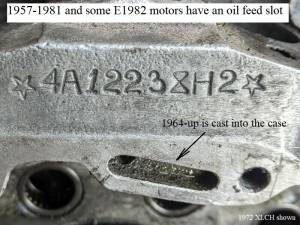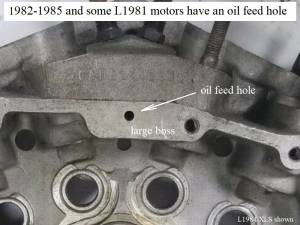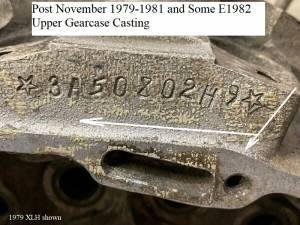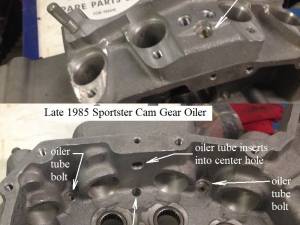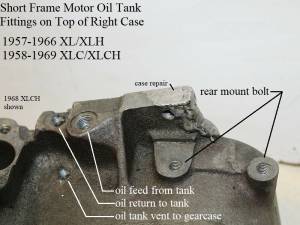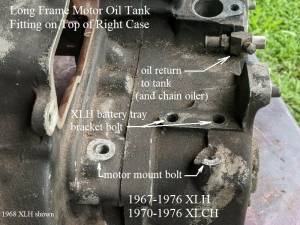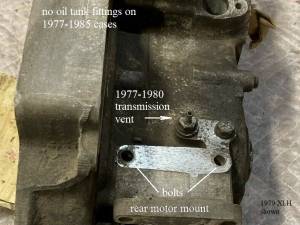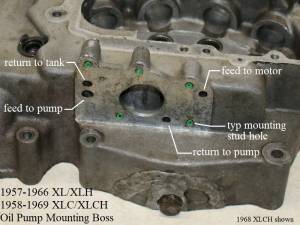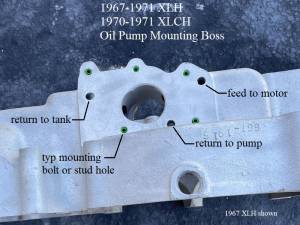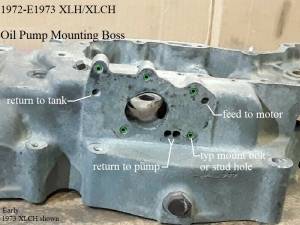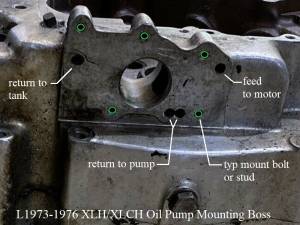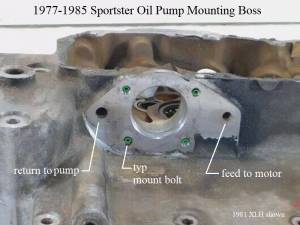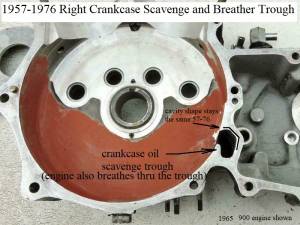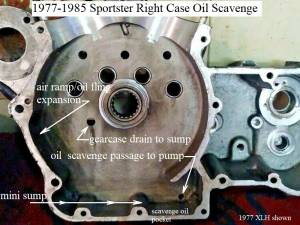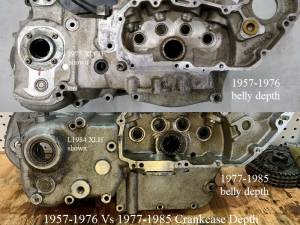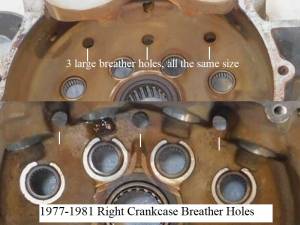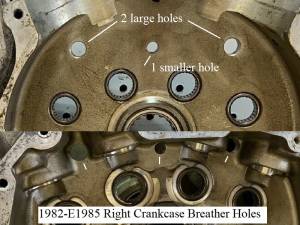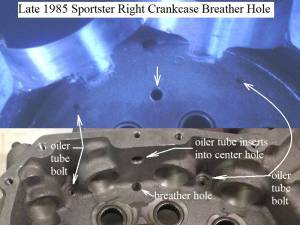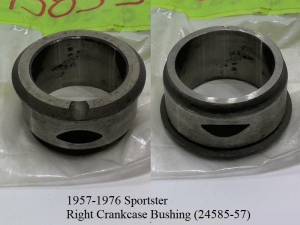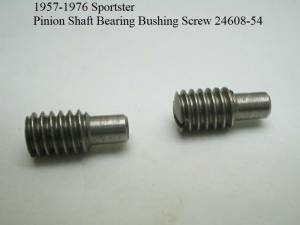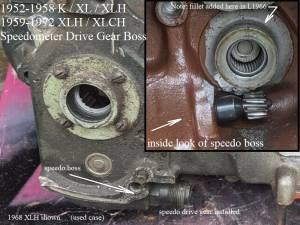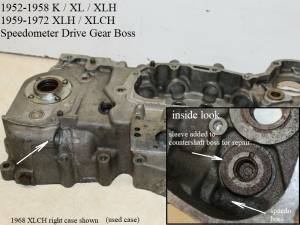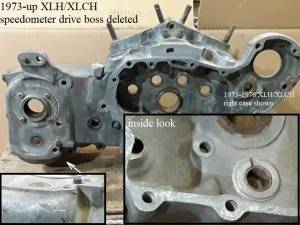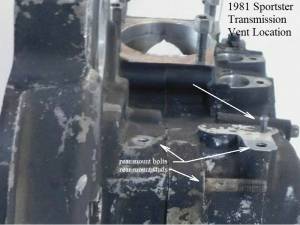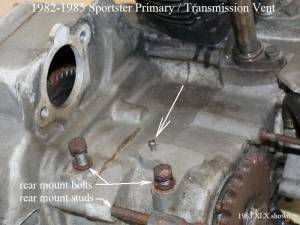Table of Contents
IH: Engine Mechanicals - Sub-01C
Ironhead Engine Case Identification
1957-1971 XLH/XLCH Cases
Short Frame vs Long Frame
Short frame motors are 1957-1966 XL / XLH and 1958-1969 XLC / XLCH.
Long frame motors are 1966-up XLH and 1970-up XLCH.
All sportsters 1957-1966 and 1967-1969 XLCH were virtually identical in design. So most parts thru that period do interchange seamlessly.
The differences that do exist are easy to deal your way around.
The XLForum seems to have adopted the term 'short frame' to describe the 1st generation bikes.
(because their frames were shorter than the 2nd generation “long frame” bikes that came into being to hold all the electric start stuff in 1967)
These motors are also known as “no hump” motors as the left cases were not cast to accept a starter (kick only cases).
1967-1969 XLH was not 1st generation design though many of these second generation parts will retro-fit to the 1st generation design bikes.
Some don't make that an easy task as they are similar but not the same. 1)
1967-up XLH and 1970-up XLCH motors are also known as “hump” motors as the left case is cast with a “hump” over the tranny to mount a starter.
In 1967, to power the starter, a giant battery was required.
To make room for this, the rear frame down tubes were offset to the rear with a “dogleg” and now the frame got longer than the original.
The original is a “short frame” and the doglegged version is a “long frame”.
See the long frame (dogleg) in the pic below. Note the position of the down tubes to the motor mount surface. 2)
Engine interchangeability
Swapping motors and frames:
1952-1976 motors will be a direct bolt-on to 1952-1976 frames (may have to deal with or add bracketry for oil tanks and battery trays depending…)
1977-1985 motors will be a direct bolt-on to 1977-1985 frames (must use the motor mounts that fit the frame year).
All 1957-1966 XL / XLCH and 1967-1969 XLCH motors are basically the same (short frame) and will be a direct swap within those year (kick only) frames.
But the 1967-1969 XLH are different (long frame “hump”) motors. From 1967-1969, there were two sportsters; Short XLCH and Long XLH.
All 1970-up bikes used the long frame.
1967-1976 electric start “hump” engines will bolt directly into the early kick only frames.
What won't bolt on from there is the matching e-start accessories (oil tank or battery box). 3)
The e-starter is well forward of the seat tubes. You may have to do a slight amount of clearancing for the aluminum starter housing.
Or just run kick only and make it real simple.
If swapping early motors into 1977-newer frames, just remember to use the front and rear mounts for the year the frame is. 4)
Short frame motors will bolt into long frames but the dog leg seat posts will show on the later frames. 5)
Swapping case halves:
You can physically bolt any 1952-1976 case halves together (need to remove center dowel pin in certain combos). 6)
That does not mean that the cylinder spigots and crankshaft will exactly line up between the two halves.
Further machining may need to be done to pair the two halves (look for a good machinist if so).
There usually is a slight mismatch at the base surfaces. It's up to each owner if you need to re-skim these.
Keep in mind the factory work is pretty damned good. It's easy to correct the surface mismatch and introduce a parallelism to crankshaft center line error. 7)
1957-1966 (All) and 1967-1969 (XLCH) Short Frame Cases
In 1952, the K model was introduced. This was a brand new design for HD.
Between 1952 and 1976, that basic bike slowly evolved.
It was built on the same “mechanical DNA” and lots of stuff directly interchanges between a 1952 and 1976.
In 1977, the basic design changed. Fitting a 1977 engine into a 1976 frame requires mods to the frame.
The F model flatheads (side valve in factory speak), from 1952 to 1956, the bike changed each year.
But the changes were evolutionary rather than revolutionary. You could pretty easily put 1956 stuff on your 1952 and vice versa.
In 1957, the OHV XL came along. This new engine was fitted to the same basic frame. It was still the same bike for the most part.
You could put the OHV engine in the flattie frame and vice versa. Same in 1958. Basically one bike so far.
In 1958, the factory took that basic bike and introduced a new model along side the XLH, the XLCH.
The XLCH is the same motor and frame and everything bolted on is just stripped down but still the same bike.
These two models, linked at the hip, were produced until 1966.
1957-1966 (all) and 1957-1969 (XLCH) are kick start only.
Click on a pic to enlarge:
| 1957-1966 (All) and 1967-1969 (XLCH) (short frame) Cases. Quick glance visuals. 8) | |
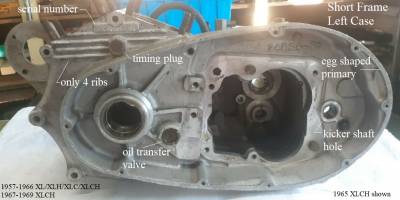 | 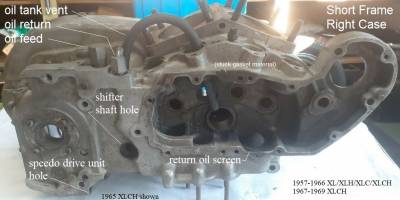 |
1967-1969 XLH Long Frame Cases
In 1967, a mutation in the DNA resulted in the 1st change away from the original design.
Electric start was offered on XLH. A “hump” was added to the left case casting above the tranny.
It was decided to put the electric starting components behind the rear cylinder mounted to the crankcase above the new case “hump”.
New (XLH only) “hump cases” with “long frames” were made to accept the new starter.
The 1967-1969 XLCH was unaffected until it also succumbed in 1970.
1967-1969 (XLH) and 1970-1976 (all) are electric and / or kick start. 9)
You may see many XLHs that added the Option Kicker Kit. 10)
1967 XLH had both Kick and Electric start as the Factory wanted to be “Certain” the Electric proved positive.
In 1968, the Kicker was gone on the XLH, you may see many that added the Optional Kicker Kit (thats how HD makes their money).
On long frames, mechanically speaking, 1967-1969 (XLH) and 1970-1971 (all) cases interchange. 11)
Cosmetically speaking, only 1967-1969 XLH cases are identical.
| 1967-1969 XLH (long frame) Right Case 14) |
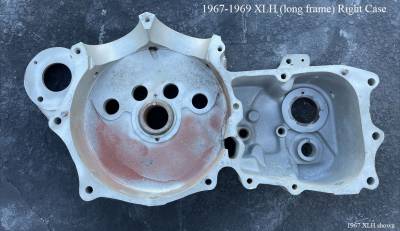 |
1970-1971 Long Frame Cases
1972-1976 XLH / XLCH Cases
1972-1976 (long frame) cases are machined for 1000cc cylinders.
There was a late 1973 cylinder and head change but the crankcase was left unchanged 15).
All 1000cc cylinders will fit into all 1000cc cases. You just have to use either 72-E73 heads AND cylinders or L73-up heads AND cylinders.
1972 right case has the hole for the speedometer drive gear that runs off the countershaft low gear in the transmission.
1973-up right case does not have this hole and the speedometer drive unit was moved to the front axle. First year for front disc brakes also.
Click on any pic to enlarge.
| 1973-1976 XLH / XLCH 1000 cases 16) | |
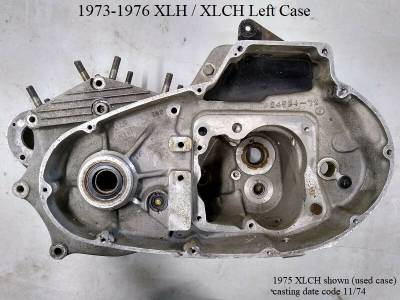 | 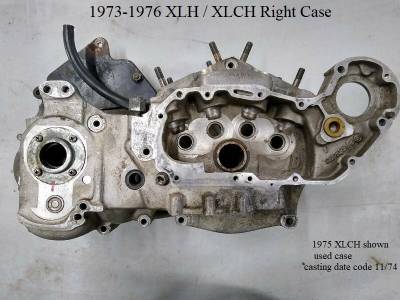 |
| 1973-1976 XLCH 1000 cases 17) | |
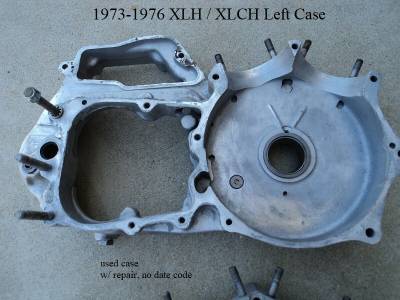 | 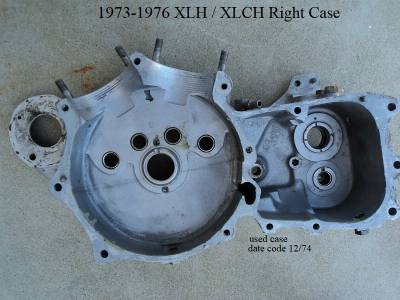 |
1977-Up Sportster Cases
Cases were redesigned in 1977 to include a mini oil sump and a new gerotor type oil pump mounting boss.
The oil collection sump is in the right case bottom and the left case bottom is sloped to drain into the right case.
A vertical oil scavenge passage is drilled in the right sump wall connecting the crankcase to the oil pump return port.
1977-up frames got a divot on the right side tube to allow removal of the oil pump without removing the engine.
Crankcase breathing was dramatically redesigned. The oil trough between the crankcase and gearcase was deleted.
The crankcase now breathes thru holes drilled in the wall between the crankcase and gearcase and the timed breather was deleted.
1980 XLH Sportster Cases
This right case has mid 1980 changes to the upper gearcase (mods the factory made to improve sealing between the cover and the case).
Belly number 780 277004 (October 4, 1979).
See Upper Oil Feed Galley below for more information.
E1984 Sportster Cases
L1984 Sportster Cases
The generator was deleted and the machined hole in the right case for the generator was also deleted.
That portion of the case is now designed for a bolt-on oil filter mount.
A stator is now mounted to the trap door. The left case has a channel cast in for the stator wiring leading to a thru hole for a wire grommet.
Specific Engine Case Features
Serial Number / Vin Pad
- 1957-1969, The engine serial number pad is a rectangle casting on the left case just above the timing hole plug.
The serial number is stamped into the left case pad on all 1969 XLH and XLCH models.- SOME LATE 1969 XLH MODELS DID HAVE A VIN PAD ON THE RIGHT SIDE CASE BUT IT WAS LEFT BLANK.
This was most likely a running change (as is seen on both case halves L69-E71) for the swap to right side VINs on all 1970 models.
The first production XLH right cases in 1969 had no VIN pad.
Right side blank pads on 1969 XLH models have reportedly been found on XLH models with VINs down into four digits.
The casting numbers on either left or right cases from 1969-E1971 did not change when the VIN pad was added.
Also the parts order# for the case set is the same from 69-E71 and the 70-E71 case set was available for order as replacement for 67-69 models.
THEREFORE, IT IS POSSIBLE that there were some 1967-1968 XLH cases replaced from the factory also with number pads on each side as well.
- 1970-E1971, The new serial number (now called VIN) and it's required casting pad is on the right side case.
The VIN is between #3 & #4 tappet blocks with stars on each side of the VIN. 26)- THERE IS STILL A SERIAL NUMBER PAD ON XLH and XLCH LEFT CASES BUT THE PAD WAS LEFT BLANK.
Here are a few comments on the left side blank pad from piniongear of the XLForum:
The reason for this is because Harley had no reason to change something until the change was important enough to do some retooling.
If they were to eliminate the raised rectangle in 1970 when the number switched to the right hand side, they would have to do retooling on the dies.
That would be a waste of good money just to eliminate the raised rectangle. So the cheapest way was to simply not stamp the number.
Even this required some retooling but it was not like doing die work.
Keep in mind that Harley never changed anything until it was absolutely necessary.
Just look at how many parts still carry the old 1952 suffix (xxxxx-52) on the part numbers from the old K Model. 27)
- L1971-1985, there is no longer a number pad cast into the left case and the right case VIN pad was shifted.
The VIN pad and number is on the right case between #2 & #3 tappet blocks with stars on each side of the VIN. 28)
| 1957-1969 Sportster Serial# / Vin Pad Location 29) | 1970-E1971 Sportster Serial/VIN Pad Location 30) | L1971-1985 Sportster Serial / VIN Pad Location 31) |
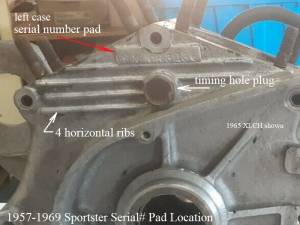 | 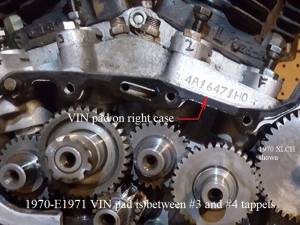 | 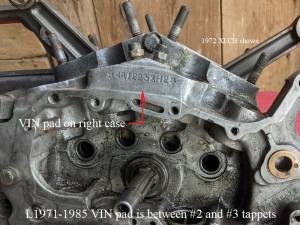 |
Counting the Ribs:
1957-1971 left cases (above pic) have 4 horizontal ribs under the serial number pad.
1972-1985 left cases have 5 horizontal ribs in that same location (below pic).
An extra rib was added in place of the number pad in 1972 when they stopped casting the number pad on the left case.
Various Numbers Found on Cases
Case Part Numbers
Click Here to see the Engine Case Number page in the Sportsterpedia.
Click Here to see an article on Part Numbers in general in the Sportsterpedia.
You will not find any part numbers on the cases that match the parts listings in the parts catalogs.
Part numbers were never cast or stamped into the cases. Each case half has many numbers on it but none of them show up in the parts books.
There were some parts that did have part numbers on them either stamped or on a sticker label.
Some electrical parts had stickers with the part number on them but no part numbers on cases.
The parts catalog listings are for logistics in which the MoCo stocks parts, sells them to dealerships and customers all under one Part Number.
Basically the part number was created to move the product, not to build the product.
Moving the product can mean, to the builders at the factory, mechanics at the dealership or to the customer.
Part numbers are used in manuals and instructions .
Part numbers are assigned after the parts are built (more accurate to be said the part will be listed as XXXX part number when it gets built).
Each case half has a casting number, not to be confused with a part number. See below.
1957-1975 case halves have their own part numbers with the set also having a part number.
That's because you could buy a full case set or you could buy a left or right case half.
1976 and up cases were only sold as a set so there are no individual part numbers for left or right case halves, only a part number for the set.
Casting Part Numbers
Click Here to see an article on Casting Numbers in general in the Sportsterpedia.
Casting numbers were created when the mold was created (casting number was “cast” into the part) and will not be stamped into the part. 33)
Casting numbers on the left and right cases look like (are coded like) part numbers but they are not.
They were put there when the case half was created (cast) and represent a certain base design.
Unlike part numbers, casting numbers do pertain to the building of the part. One could also call them design numbers.
A casting part number does not pertain to any certain model.
Many different year / model motors may carry the same casting numbers but there will still be differences that are important to know.
When the main design changed, so did the casting numbers, but not until then. However, the part number may change several times.
Example: 1957-1976 right cases all carried a -57 casting.
Short frame right cases have 3 fittings tapped behind the rear cylinder for oil tank fittings.
However, the E-start year cases (long frame) only have one fitting tapped for the oil return.
These tapped holes are vertically drilled thru to either the oil pump or cam chest.
But the casting part number (24558-57) stays the same even though the machining changed.
Example: 1977-1980 Sportster cases carried the same left casting number (24534-75) and the same right casting number (24558-75).
The main case design was the same but within these years, there were 4 different part number changes.
Different machining (kicker or no, oil galley slot or hole etc) took place that made a new part number.
So even though the main design and casting numbers are the same, there are still different features between them.
These different features may or may not pose a problem when mixing cases or ordering parts and gaskets.
Casting part numbers per years used:
- 1957-1966 XL/XLH and 1958-1969 XLC/XLCH: Left case (24534-57), Right Case: (24558-57)
- 1967-1971 XLH: Left case (34-67), Right Case (24558-67)
- 1972 XLH/XLCH: Left Case (24534-72), Right Case (24558-72)
- 1973-1976 XLH/XLCH: Left Case (24534-72), Right Case (24558-73A)
- 1977-1980 XL/XLCH/XLCR/XLS: Left Case (24534-75), Right Case (24558-75)
- 1981-1982 XL: Left Case (24534-81), Right Case (24558-75A)
- 1981-1982 XLS: Left Case (24534-81), Right Case (24558-75B)
- 1983 XL/XLS: Left Case (24534-83), Right Case (24558-83A)
- 1984 XL/XLS/XLX: Left Case (24534-83A), Right Case (24558-83B)
Date Codes
Early model cases did not have any manufacturing date codes.
Else you should find, somewhere on the outside of each case half, a set of numbers representing the day and the year that part was cast.
In the early years, usually there will be 4 numbers (2 for the month followed by 2 for the year, last two digits).
In later years, a slash was added between the month and year. Example: (12 64 is December 1964), (12/75 is December, 1975)
When reading this number code, keep in mind that the months for new models range from late June to early July.
A case that was cast in January of 1964 was most likely made for 1964 models.
A case that was cast in December of 1964 was most likely made for 1965 models.
Looking over many casting date codes and cross referencing that with known VINs can give a clue to how close these events were to each other.
They should be within a month or two apart (the exact day of machining can't be deciphered from these numbers).
The casting date shows what month but not what day and the serial/VIN doesn't have anything to do with dates.
So that process is not very useable on 1957-1974 models without further information.
On 1975-1985 models, matching the date code and crankcase numbers is easier since the crankcase number has the Julian date code system.
That gets you a certain day and month the case was machined then of course the casting date will be a month or two before that.
- The 1975 XLCH left case below has a casting date of 11 74 (November, 1974) which does put it in the 1975 model season.
Also, the crankcase number is 775 351 102 which marks it to be used on a 1975 model, machined on December 17, 1974.
Those two sets of numbers match within reason (cast in November 1974, machined December 17, 1974).
The finished bike could have been originally sold between December and the following January of 1975.
(if using just these numbers alone for identification)
Crankcase Numbers (AKA Belly Numbers)
Belly numbers don't have anything to do with issuing a VIN and they will not tell you specific model info (XLH or XLCH).
Engine serial / VIN numbers are added much later after assembly. 35)
Belly numbers tell you that a particular set of cases was paired up and finish machined together (line boring, cylinder base surfacing etc).
The belly numbers will tell the year model that the cases are intended to be used on.
And also either a sequential number (57-74) or Julian date and sequential number (75-85).
Each case half should have the same exact belly numbers.
- On 1952-1974 motors, the belly number is on the outside of the motor (bottom of each case half under the flywheels).
- On 1975-E1984 motors, the MoCo began using a Julian Day Code system for belly numbers.
Click Here to view the Julian Calendar page in the Sportsterpedia for full year calendars.
The belly numbers on the right case are on the outside and the belly numbers on the left case are on the inside of the motor.
Right case still has the numbers on the bottom under the wheels.
Left case has the numbers on the outer primary wall (primary cover removed).
(technically, the left crankcase numbers really aren't belly numbers anymore) - On L1984-1985 motors, the location of the right crankcase numbers were changed to aid the stamping operation
Right case belly number was moved to the right side (outer sump wall) just under the gearcase starting with #784 044001 (February 13, 1984) 36).
This DOES NOT coincide with the L84 alternator change but rather after so there are some alternator motors that have right case numbers on the belly.
Left case number location didn't change, still on left outer primary wall.
| L1984-1985 crankcase number locations 39) | Example using Julian Calendars in SP | |
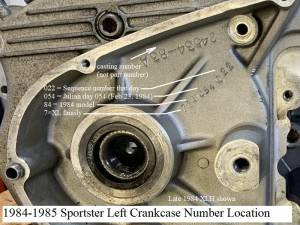 | 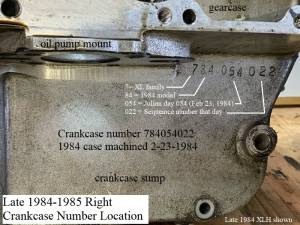 | 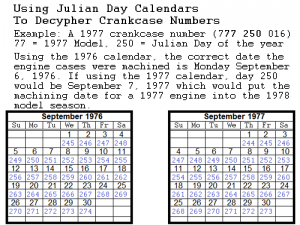 |
Case Match Numbers (1975-Up)
In addition to belly numbers, there is a second set of numbers on 75> motors on each case half that should match.
This was added the same time the left case belly number moved from the belly to the primary wall on 1975 models.
For lack of public documentation, we'll call these Case Match Numbers and they represent the fact that those two case halves were mated as a factory pair.
These will most likely be a letter(s) and numbers but the exact number set should be on the outside of each case half opposite one another.
The factory belly numbers should be the same and the case match numbers should also be the same.
There does not seem to be any connection between the case match numbers and belly numbers (no date coding visible on case match numbers).
- On 1975-E1984 and earlier, they'll be under the generator.
- On L1984-1985, they'll be under the oil filter mount (same location, different part above the numbers).
Serial or VIN Numbers
These numbers pertain to the whole bike, not just the engine. Coding for these numbers changed over the years.
Click Here to see the VIN page in the Sportsterpedia for specific information on serial/Vin numbers.
An XLCH may have many different parts, over the whole bike, than an XLH, including the engine.
The serial/VIN number was (most likely) the last number to be stamped onto the engine case from the factory.
1957-1969 Sportsters are titled to the engine only so the motor serial number is your proof of ownership of the entire bike.
1970-up Sportsters are titled to the frame only so the motor VIN number has nothing to do with ownership of the bike.
However, having the motor VIN matching the frame VIN is a plus for those who want factory original parts.
And it helps toward the value (or haggle factor) on resell but the VIN is not the only factor in whether you have an original engine or bike.
Case Drains
Click Here for more information on Sportster drain plugs in the Sportsterpedia.
Case drain features from 1957-1985:
- 1957-1966 XL/XLH, 1958-1969 XLC/XLCH
- Crankcase plug on right case under the flywheels is very close to the seam between the cases. Do not remove unless necessary.
- Transmission drain is further away from the case.
- No primary drain.
- 1967-1969 XLH
- Crankcase plug on right case under the flywheels is very close to the seam between the cases. Do not remove unless necessary.
- Transmission drain.
- Primary drain.
- L1969-1971
- Crankcase drain boss was not factory drilled and tapped for a plug. These years shared the same cases.
- Transmission drain.
- Primary drain.
- 1972-1976
- 1972, Crankcase drain boss plugged again. Do not remove unless necessary.
1973-1976, Crankcase drain plug was moved further away from the seam. Do not remove unless necessary. - Transmission drain.
- Primary drain.
- 1977-1985
- Crankcase drain deleted. There is a vertical rifling hole at rear of right case plugged on the bottom.
It can be used for a drain but will not drain the entire crankcase due to large case bolt bosses. - Transmission drain on right case was deleted.
- Primary drain used to drain primary / tranny compartments.
Left Case
Primary Cover Mounting Holes
- 1958-1969 XLC/XLCH cases:
- The left picture below is a 1964 XLCH left case. It can be used on any short bike.
Notice the 4 blue and 3 yellow circles drawn on the picture.
On 1958-1969 XLC / XLCH, these are all tapped holes for the primary cover. - Uses cover gasket (34952-52).
- 1957-1966 XL / XLH cases:
- In the left picture below, the holes at the yellow circles are not drilled or tapped.
The holes at the blue circles are not tapped but have 3/16“ dia roll pins. 48)
The right picture below is of a 1960 XLH left case.
In this case you don't have all the screw holes needed for the tin primary cover used on 59-69 CH.
You'd need to use the 3 hole sportster cover or pull the pins and drill and tap to convert to tin cover. - There are (3) 1/4”x20 tapped holes, one of which is on the primary wall, for cover mounting screws. Uses cover gasket (34952-52A).
- 1967-1976 XLH and 1970-1976 XLCH cases:
- There area (10) 1/4“x20 and (1) #10-24 tapped holes for cover mounting screws. Uses cover gasket (34955-67).
- 1977-1985 (all):
- There are (10) 1/4”x20 tapped holes for cover mounting screws with the addition of a chain adjuster stud under the engine sprocket protruding thru cover.
Chain adjuster stud replaces previous lower front screw and is threaded for a nut to the cover. - All, except 1980-1982 XLS, use gasket (34955-75). 1980-1982 XLS uses the black version gasket (34966-80) to match the case/cover.
Kicker Shaft Hole
- 1957-1966 XL/XLH and 1958-1969 XLC/XLCH are kick start only motors.
All have a bushed hole and starter gear stop on left case just to the right of the transmission compartment. - 1967-1969 XLH and 1970-E1980 (all) have both a starter hump on the left case and a bushed hole/gear starter stop.
- 1967 XLH (only) had a starter and a kicker.
- 1968-E1980 XLH was electric start from the factory with an option for kick start (kicker hole machined but plugged).
- 1970-1979 XLCH came factory with a kicker and a block-off plate at the starter hump.
- L1980-1985 Sportsters came factory with electric start only and no provision for a kicker (hole/gear stop deleted in case).
Left Crankcase Oil Scavenge
Click Here for more information on crankcase oil scavenging paths.
- 1957-1976 engines:
- There is a trough in the rear of the crankcase to carry excess oil to the oil trap at the oil pump.
The left case oil trough mates up to the right case oil trough where excess oil and air is expelled at the oil pump.
On 1957-1971 (900s), the left trough has a different profile than the trough in the right case.
On 1972-1976 (1000s), the left case trough more matches the right case trough.
The right case trough pretty much stayed the same profile from 1957-1976. - Crankcase breathing is also accomplished through this trough and the right case.
(then to the breather valve at the oil pump and finally out a tube in the valve cover)
- 1977-1985 engines:
- The oil trough in both cases was deleted with the addition of a minisump and gerotor pump.
- A mini sump was added to the both case halves. Left case sump designed for oil to be blown or drained to the right case bottom.
- The lower front wheel area was expanded allowing air under the wheels to usher oil to the rear pocket of the sump.
A channel is cast into the front case floor to steer oil flung off the wheels to the right case. - Oil scavenging to the pump and engine breathing is done by way of machining in the right case.
Right Case
Cylinder Boss
- Cylinder Bore:
- 1957-1971 Sportster motors are 883cc (respectfully labeled “900”)
- 1972-1985 Sportster motors are 1000cc.
- The cylinder studs have a different spacing than 900 cases.
- The cylinder spigot hole in the cases is wider to accommodate 1000 cylinders.
- Tappet Block Clearance:
- 1957-1971 cases, the side of each cylinder base is slightly milled at the intake tappet and is barely noticeable.
- 1972-1985 cases, the side of each cylinder base is milled heavily at the intake tappet and is very noticeable.
Upper Oil Feed Galley
Oil feed comes from the oil pump to the motor thru internal passages in the cam cover.
The gearcase floor has an internal hole from the oil pump inlet to feed into the cam cover bottom.
There is a (relatively) vertical internal feed galley in the cam cover that does not enter the gearcase.
Oil then transfers to the engine in two separate places, a hollowed pinion shaft to crankpin and the top of the gearcase to the rocker box lines.
- 1957-1981 and some E1982 cases have an elongated angled front to back slot for the oil feed galley in the top of the gearcase.
A hole is then drilled thru the left end of the slot to feed each rocker box oil line.
The casting above the oil slot is taller in that area especially on 77-E79 motors.
Cam Cover gasket was modified (25224-52A) to help control leaks by adding a slot to the oil feed hole.- Slot construction (for those with the slot): 60)
On 1957-1963 models, the slot is plunge cut with and end mill.
On 1964-up models, the slot is cast into the case.
- M1980 Upper Gearcase Casting Change:
In November of 1979, the MoCo realized a possibile high pressure oil leak around the upper oil seam between the cam cover and the gearcase. 61)
The case casting was reworked and modified to eliminate this possibility.
The upper feed galley (slot) profile was changed. The top boss on the gearcase was shaved back.
The cover gasket (25224-52A) was modified to fit the revised castings and help eliminate possible leaks on earlier crankcases. - 1982-1985 and some L1981 cases do not have an upper feed oil slot.
The slot was deleted and the large boss is cast around the feed galley area.
Oil is fed to the rocker box lines simply by way of a hole drilled thru the large boss in the upper gearcase. - L1981-E1982 Overlap: L1981-E1982 engines may have one of two different types of gear case cover and crankcase set combinations. 62)
- Cases with the small boss and oil slot use gasket (25224-52A).
- Cases with the large boss and oil hole use gasket (25263-81).
- L1985 Upper Feed Galley Addition: Feed galley tapped into to add an oil spray on the cam gears from crankcase (785 303 002).
Click Here for more information on the cam gear oiler.
Oil Tank Fittings
Click Here to reference the Ironhead Oil Tank, Lines and Routing page in the Sportsterpedia.
- 1957-1966 XL/XLH and 1958-1969 XLC/XLCH have three oil tank fittings on top of the right case behind the rear cylinder.
- Oil feed from the tank, oil return to the tank and oil tank vent fittings.
There are galleys built into the case that run internally (feed and return go to oil pump respectively and tank vent goes into cam chest).
- 1967-1976 XLH and 1970-1976 XLCH have only one oil tank fitting on top of the right case behind the rear cylinder.
- Oil return fitting to the tank.
Oil feed runs from the tank to a fitting on the back of the oil pump.
Oil tank vent runs from the tank to the 90° fitting on the back of the cam cover.
Oil return still runs internally to the oil pump.
- 1977-1985 XLH/XLCH/XLS/XLX motors do not have any oil tank fittings on the case or the respective oil galleys as previous years.
- Oil tank feed and return both run to the oil pump externally.
Oil tank vent runs from the tank to the 90° fitting on the back of the cam cover into the cam chest.
Oil Pump Mounting Boss and Oil Passages
Click Here to reference the Ironhead Oil Pump page in the Sportsterpedia.
Note: Mixing full oil pump assemblies and engine cases is much easier than mixing individual oil pump parts.
1957-1976 cases use a gear driven type oil pump.
Any 1957-1976 Sportster oil pump (as an assembly) will bolt up to all 1957-1976 motors but the plumbing has to be taken into account.
1957-1976 oil pumps will not bolt to 1977-up cases.
- Plumbing: From 1957-1976, there were 3 basic oil pumps with 2 different plumbing styles 70).
The 2 different pump plumbing styles match the plumbing on the 2 different case mount styles for these years.- 1957-1966 XLH and 1958-1969 XLCH (short frame) have 2 feed and 2 return passages thru the oil pump mounting boss.
The feed (inlet) and return (outlet) fittings on top of the case sit over vertical drilled passages down to the rear of oil pump mount.
The front side of the oil pump mount has a feed (outlet) and a return (inlet) hole each. - 1967-1976 XLH and 1970-1976 XLCH (long frame) have only 1 feed and 2 return passages thru the oil pump mounting boss.
The return (outlet) fitting is still on top of the case with a vertical drilled passage down to the rear of oil pump mount.
It ends up in the same place as in previous models.
The feed passage from the tank was deleted from the case (now feeds to the back of the oil pump).
The front side of the oil pump mount has a feed (outlet) and 2 side by side holes at the return (inlet) hole.
- Breather Oil Screen: The breather tower oil screen was deleted in L1973.
- 1957-E1973 Sportster cases have a machined area rearward in the breather tower bore to add a screen between tower slot and oil trap.
- L1973-1976 Sportster cases do not have this machined area, have no room for an screen and the oil trap shifted slightly clockwise.
1977-1985 cases use a gerotor type oil pump.
Any 1977-1985 Sportster oil pump (as an assembly) will bolt to all 1977-1985 cases. 1977-1985 oil pumps will not bolt to 1957-1976 cases.
L1983-1985 gerotors will mount to 1977-E1983 pumps but will destroy them. Click Here for more information on L1983 pump changes.
- Plumbing:
- There are only 2 oil passages on the pump mounting boss, feed to the motor and return to the pump.
- The pump has fittings on it for feed from and return to the oil tank. Oil tank vents to a 90° fitting on the cam cover.
| 1957-1971 breather tower bore with machining for oil screen 71) | 1972-E1973 breather tower bore with machining for oil screen 72) | L1973-1976 breather tower bore has no machining for oil screen 73) |
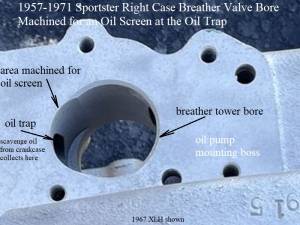 | 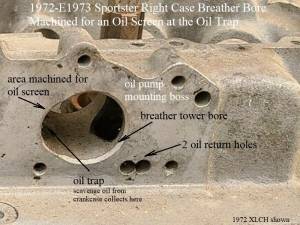 | 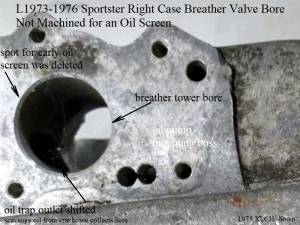 |
Right Crankcase Oil Scavenge / Engine Breathing
Click Here for more information on crankcase oil scavenging paths.
Click Here for more information on crankcase ventilation.
- 1957-1976 engines:
- There is a trough in the rear of the crankcase to carry excess oil horizontally to the oil trap at the oil pump.
- Crankcase breathing is also accomplished through this trough to the breather valve at the oil pump and finally out a tube in the valve cover.
- 1977-1985 engines:
- The oil trough, oil trap and breather gear was deleted from the cases with the addition of a minisump and gerotor pump.
- Oil is scavenged from the sump uphill to the oil pump from the drilled hole in the rear at the oil scavenge pocket.
A horizontal hole intersects the vertical hole behind it carrying oil to a second horizontal hole that feeds the pump return inlet. - The crankcase now breathes thru holes in the wall between the crankcase and gearcase and finally out a breather valve in the cam cover.
- 1977-1981 right case has 3 same size holes through the wall between the crankcase and gearcase for breathing.
- 1982-E1985 right case has 2 large and 1 smaller hole in the center on the wall for breathing.
- L1985 right case, from (#785 303002) manuf. after 10-29-1984, has a cam gear oiler installed against the cam wall over the cams.
The tube is fed from a tee in the tube center to the upper feed galley.
A vertical hole was drilled thru the feed galley connecting feed oil to the cam chest. The hole is plugged at the top.
This allows feed oil to spray the cams using tiny holes in the tube (more of a drip at idle).
The two large breather holes were instead drilled and tapped for screws for the oiler tube.
So L1985 crankcases have only the one small hole in the cam wall to breath thru.
(the oil scavenge path also allows air pressure to pass back to the tank then the cam chest as usual)
Pinion Shaft Bearing Bushing (1957-1976)
1957-1976 Sportster right case bushing (24585-57) is held in place by way of set screw pins.
Sportster Pinion Shaft Bearing Bushing Screw Part# (24608-54) x 2.
1977-up Sportster right cases do not use this bushing or screws.
Transmission Countershaft Boss
The transmission countershaft boss changed over the years for strengthening issues.
The 52-53 is the 1st iteration of the design. Each after that is noted as to the upgrade.
Starting L1966 with engine number (66XLCH 6117) on 1-13-1966, a fillet was added at the base of the countershaft low gear boss.
Also, new countershaft low gear has a counterbore to provide clearance at this point.
The old countershaft low gear can not be used on crankcases having the fillet on the countershaft bushing boss because it will jam against the fillet. 87)
Here is a cross section view of the right case at the countershaft boss.
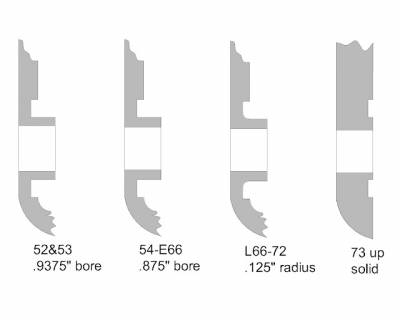 88)
88)
Speedometer Drive Gear Boss
- 1952-1972 K/XL/XLH and 1959-1972 XLCH models use a mechanical speedometer run by a (11T) drive gear unit meshed at the trans countershaft.
The drive gear screws into the boss built into the right case for it. This area of the case is notorious for blowing out. - 1973 AND LATER CASES DO NOT HAVE THE SPEEDOMETER DRIVE AT THE COUNTERSHAFT BOSS.
The drive gear was deleted on the right case and the new drive unit runs off the front wheel axle.
The drive unit boss thru to the inside housing on the right case was also deleted. This leaves more material in that area and more strength. 89)
Primary / Transmission External Vent (1977-1985)
1957-1976 models vent the primary / transmission thru the motor internally via the oil transfer valve so there is no external vent.
Click here to read more on the transfer valve in the Sportsterpedia.
1977-1985 models vent to atmosphere out the back of the motor from the top of the transmission near the rear motor mount just behind the solenoid.
Click here for more information on the trans/primary vent in the Sportsterpedia.
- 1977-1980 models:
- The transmission was vented to atmosphere starting in 1977.
The vent fitting is threaded into the right case at the inner hole closest to case parting seam (previously battery box / oil bracket bolt location).
The inner hole is in a position where trans oil doesn't seem to get tossed around as much so it doesn't eject much oil.
All 76< long frame cases (except 71ch) will accept the vent bolt in the 77> position.
Conversely installing the vent bolt in any of the four short frame rear mount bolt holes usually results in drips from the vent. 93)
This particular fitting works with either the Prestolite or Hitachi starters.
- 1980-1985 models:
- These models have a 1/4“ OD metal tube (26272-81) pressed into the right case instead of a threaded fitting.
The smaller nipple works with the beefier Nippon Denso starter change in 1981.
1981 cases: The pressed-in vent nipple is on the top right of the case just under the end of the (new type) starter solenoid.
1982-1985 cases: The pressed-in vent nipple was moved farther in toward the center, still under the solenoid (back to 77-80 location).
Motor mounts
Click Here to view the Ironhead Motor Mount page in the Sportsterpedia.
Rear mounts
- 1957-1966 XLH and 1958-1969 XLCH (short frame):
- These use the 4 hole rear mount and the cases also have 4 top holes and 3 middle studs to hold rear mount to the cases.
All 1966 and earlier bikes were kick start only. One mount and one case configuration covered all models. 97)
- 1967-1969 XLH (long frame):
- In 1967, the first electric XLH came out and to fit the starter, the cases and the mount were changed from 4 bolt to 2 bolt / 3 studs on XLH only.
The front two bolts were dropped to make room for the electric leg (battery box / oil bracket bolted in the vacated area).
Then there were two mounts and two case sets, one each for 1967-1976 XLH and 1967-1969 XLCH. 98) 99)
- 1970-1985 All (long frame):
In 1970, the old 4 bolt cases/mounts were dropped completely and the XLCH was redesigned.
It was now based on the electric start bike, with the starter removed and a kicker fitted instead.
This is how the 1970-1976 XLCH is built (as a stripped down XLH rather than the old traditional kick only design). 100)- 1970-1981 rear mounts have the hole in middle for a kicker.
- 1982-1985 rear mounts do not have the kicker hole.
Lower Front Mounts
Always use the style front mounts that match the frame year intended.
- 1957-1981 models use the same style lower front mounts.
- 1982-E1984 models use a slightly different version (still bolts to engine the same but frame mounts moved slightly).
Left mount has built in oil filter fittings. - L1984-1985 lower front mounts had a radical change.

